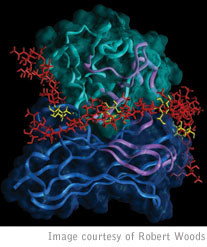


Sweet Dreams
by Kathleen Cason
Intro
| Charting the course
| The team's beginnings
| The pitch
Cross-country caravan
| The gathering
| Collaborations

 CCRC scientists have pioneered new research
methods that have advanced studies of complex
carbohydrates. For example, using computer
simulations, CCRC scientists discovered how
a carbohydrate shed by a deadly strain of
streptococcus B docks with antibody molecules.
Understanding this interaction may yield clues
for designing new vaccines and drugs against
strep B infections.
CCRC scientists have pioneered new research
methods that have advanced studies of complex
carbohydrates. For example, using computer
simulations, CCRC scientists discovered how
a carbohydrate shed by a deadly strain of
streptococcus B docks with antibody molecules.
Understanding this interaction may yield clues
for designing new vaccines and drugs against
strep B infections.
Collaborations
The University of Georgia should be very proud of the CCRC. There are not many times UGA can say,
‘We’re the best in the world’ at something. This is one of them,” said Gerald Hart, department
director and biological chemistry professor at Johns Hopkins University School of Medicine.
Today, UGA is one of only three places in the world with the equipment and expertise under one roof
poised to make major advances in understanding complex carbohydrates. These molecules are important
in plant growth, cancer, arthritis, vaccine development and a myriad of other areas important to
health as well as basic science.
“The CCRC’s strengths are in analytical methods, molecular modeling and NMR structural approaches.
The CCRC is at the forefront worldwide,” said Hart, who chairs the center’s advisory committee on
biomedical research.
In October 2003, CCRC personnel assembled under their new roof. Nearly 200 researchers and support
staff moved into a new, approximately 140,000-square-foot building. The equipment inside is worth
nearly as much as the $39 million building.
The new building — whose exterior could pass for a Colorado ski resort — is designed to pull people
together and encourage informal interaction. Sound familiar? That’s where the good ideas come from,
Darvill said.
Nine interactive areas are outfitted with comfy chairs and sofas, coffee machines and marker
boards. Glass-walled staircases are intended to foster interactions among levels of the three-story
building. From the outside the facility looks huge but interior spaces are ingeniously intimate.
So far, the CCRC has dominated two areas of research: unraveling the structure of plant cell walls
and developing methods to study complex carbohydrate structures. Both areas are contributing to the
advances being made on the biomedical front.
The Albersheim-Darvill mantra of collaboration is reflected not only in the new building’s
architecture but also in the research that takes place inside.
At any one time, more than 100 collaborations are under way: among CCRC research groups, with other
UGA faculty and with scientists at private, university and government labs worldwide.
Many of these collaborations promise to benefit us all. For example, CCRC discoveries with UGA
textile scientists may lead to major changes in the textile industry — altering the way dyes or
antibiotics or permanent press compounds are attached to cellulose fibers and resulting in less
pollution. Joint research with scientists at the UGA vet school may lead to better vaccines for
humans and animals that are based on microbial carbohydrates. In a combined effort with Houston’s
M.D. Anderson Cancer Institute, CCRC researchers discovered and patented a component of aloe and
other plants that protects skin from UV light damage, even after sun exposure. The compound has
huge potential as a sunscreen additive.
“Collaborative research — sharing equipment, students, ideas and grants. It’s the hallmark of this
place,” Darvill said. “It’s one reason why we’re so successful. It’s not just one person, it’s
everyone.”
Darvill runs the CCRC’s day-to-day operations these days. He not only directs his own research
program but also provides a sounding board for others.
Albersheim plans to finish a book and establish a $100 million endowment for the center. He may
even get back in the lab to pursue his notion that complex carbohydrates may have a role in memory.
For Albersheim and Darvill this new beginning surpasses their early ideas and imaginings.
“You can’t dream this,” Albersheim said. “It’s too much.”
For more information, check out the CCRC Web site at www.ccrc.uga.edu
or contact Alan Darvill at
adarvill@ccrc.uga.edu and Peter Albersheim at
palbersh@ccrc.uga.edu.
Kathleen Cason is associate director of Research Communications at the University of Georgia.
Intro
| Charting the course
| The team's beginnings
| The pitch
Cross-country caravan
| The gathering
| Collaborations
For comments or for information please e-mail the editor: jbp@ovpr.uga.edu
To contact the webmaster please email: ovprweb@uga.edu
![]()